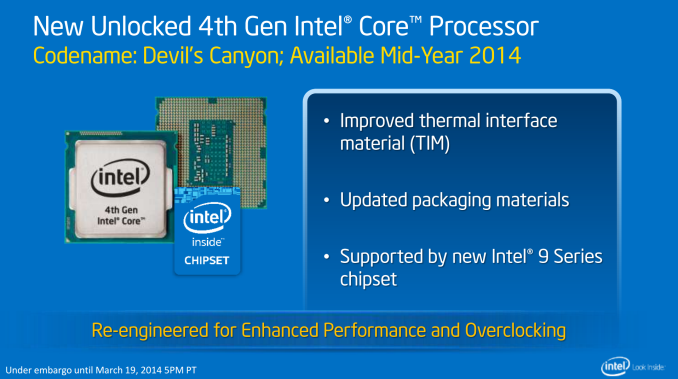Intel 2014 Enthusiast Processors: New Haswell K with Overclocking Enhancements
by Ian Cutress on March 19, 2014 8:00 PM EST
Rewind back to the launch of Intel’s 3rd generation processor, Ivy Bridge. Enthusiasts and gamers who overclock the top end model were a little disappointed with the maximum CPU frequency that could be achieved. What used to be a 5.0-5.2 GHz ceiling on Sandy Bridge became 4.8-5.0 GHz on Ivy Bridge, and there was more of a silicon lottery as to whether the user got a good overclocking chip or not. Then move forward to Haswell, and the situation compounded in a similar way. 4.6 GHz to 4.8 GHz became the norm on Haswell, a 200 MHz drop which absorbed any IPC increase the new architecture had.
One of the reasons that enthusiasts attributed to this decrease in overclocking was the thermal interface material between the die on the package and the heatspreader. Various experiments by enthusiasts with removing the heatspreader and replacing the TIM inside the CPU to provide better contact and heat transfer characteristics. The adventurous users even used metallic binding material, but the benefits were published for all to see – depending on how good (or bad) the CPU was in the first place, up to a 20ºC drop was seen for overclocked processors at full load.
As part of the Intel press conference call this week, it was announced that a new Haswell processor will come to market to help adjust some of these issues. This new processor will be a fully unlocked Haswell core, codename ‘Devil’s Canyon’ and should be out mid-year (note, Computex is in June). The features that Intel is promoting are the improved thermal interface material, an updated packaging and 9-series chipset support.
‘Improved TIM’ is a little ambiguous – whether this means a more substantial amount of goop under the heatspreader or a proper metalling binding to the heatspreader I do not know, although I have asked Intel. Updated packaging could lead to a thicker/thinner heatspreader, focusing more on the hot areas of the die, or a different binding agent between the PCB and the heatspreader. It may turn out easier to remove the heatspreader if needed, or harder. The final comment had me a little confused, saying 9-series support but not saying anything about the 8-series. I would assume that as a Haswell processor this new SKU would have 8-series support, although Intel have told us that this new CPU is not targeted at 8-series.
There is no word if this is going to be placed at the same frequency as the i7-4770K or the i7-4771/4790, the name or the rated TDP. Intel will let us know nearer to release, and as soon as we get this information and are able to share with you, we will.










23 Comments
View All Comments
V3ctorPT - Thursday, March 20, 2014 - link
Just like me... No way I'm spending more money, I already bought a Sabertooth board (5 year warranty), to see if I could dispense some generations of cpu's... and with Mantle, DX12 in the future I'm not seeing my 4770k starving my 2x7970's in new games anytime soon...caladbolg - Thursday, March 20, 2014 - link
According to them, changes in the microcode have been made that force it to be series-9 only. Kinda understandable if they managed to lower cycles required for heavily used actionsMrSpadge - Thursday, March 20, 2014 - link
The slide says the chip is supported by 9 series chipset. It does NOT say that the chip would NOT be supported by 8 series chipsets as well. Relax and see what it's really going to be,coolhund - Thursday, March 20, 2014 - link
Nothing was busted. Temps werent even close as good with the best generic paste compared to liquid metal.So it is mainly the TIM, not only the clearance.
Vinny DePaul - Thursday, March 20, 2014 - link
So users will have to pay a premium. I wish AMD will come up with some better CPU or software companies release softwares with better multi-core support.Homeles - Thursday, March 20, 2014 - link
It's almost undoubtedly going to be the cost of a normal K-series processor. They often sell for less than their locked counterparts. So no, there likely won't be a premium for these.toyotabedzrock - Thursday, March 20, 2014 - link
They should have never released the Cpu with that kind of thermal interface mistake. Intel usually tests things better to avoid this, but maybe since they limited over clocking the issue was not voiced by as many people.N2H4+C4H9NO=? - Thursday, March 20, 2014 - link
Hopefully this becomes the new base trend for Intel, and all processors launched from here-on will go back to having solder, or at the very least, non crap-tastic TIM.HexiumVII - Friday, March 21, 2014 - link
Wow all of intels "news" i just them reverting back to their old ways, cheap o/cers and solder from Sandy Bridge. Lets get something really new intel!willis936 - Friday, March 21, 2014 - link
I'm pretty okay with some of these "old" ways.